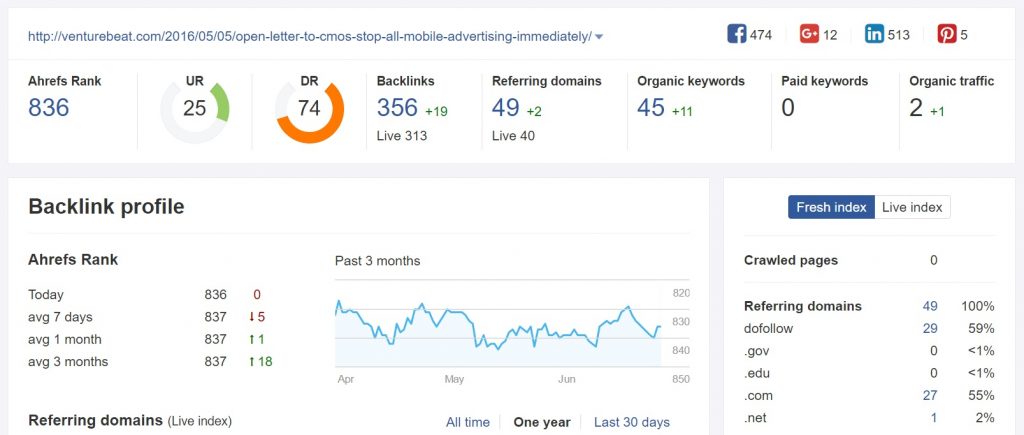Mobile advertising in its current state is a complete boondoggle. Consumers hate it, the metrics are awful, and the ad agency community is doing a disservice to clients by promoting it.”
The above quote comes from this article by Scotty Moore, titled “Open letter to CMOs: Stop all mobile advertising immediately.” I’ve never written a marketing article rebuttal before, but since this piece somehow managed to get nearly 400 backlinks and over a thousand social shares, I decided it was time for a first.

Let me just first say that as an oft-published marketing writer, I understand the challenge to stand out in a noisy market. I understand the need to take a unique angle or be controversial. I get it.
But attacking mobile advertising is like saying the smartphone was a bad idea and will never go anywhere… now… in 2016… while the smartphone industry is sitting at $400 billion.
Businesses will spend more than $100 billion in 2016.
$100 billion… SPENT!
Now, let’s be honest – marketers can be notoriously negligent with their ROI tracking, but businesses don’t simply throw away money to the tune of $100 billion. If that much money is being spent on mobile ads, it means that hundreds of thousands of businesses are seeing a return.
And case study after case study confirms this, as do the relevant statistics:
- 96% of marketers currently use or are planning to incorporate mobile marketing into their marketing mix
- 85% report an intent to raise their mobile budgets in the near future
- 84% use mobile websites; 78% mobile search; 76% mobile apps and 75% mobile display ads
- 42% report an ability to prove ROI
On that note, let’s break down Moore’s article and address the numerous problems therein.
1. Mobile Banner Ads ≠ Mobile Ads
The core of Moore’s argument is based on an article he read claiming 60% of mobile banner ad clicks are unintentional.
For starters, Moore misquotes this statistic as “60% of mobile ad clicks” when it is referring specifically to mobile banner ads, which are only a subset of mobile advertising.
Moore claims that this one article was enough to completely overturn his views after 20 years in advertising. That induces skepticism as-is, but let’s take a closer look at the study itself.
Users surveyed for the study reported seeing these banner ads in the following settings:
- checking the news (65%)
- using social media (50%)
- playing games (47%)
- watching videos (45%)
- listening to music (45%)
What we are looking at here is the type of mass-market, volume-based advertising that is expected to yield a low click-through-rate (CTR). When advertisers pay for mobile ads on these types of sites, they are typically paying well under $1.00 per thousand views and are simply hoping to catch the occasional buyer based purely on volume.
In other words, this is as untargeted as advertising gets.
With the small size of mobile screens and the bug-ridden code with which mobile banner ads are often displayed, it’s no wonder many of the recorded clicks are unintentional.
Ultimately, however, this doesn’t matter in the slightest, because…
2. Click Through Rate (CTR) ≠ Return On Investment (ROI)
Where Moore truly missteps is in his attempted application of the previously mentioned statline:
“If you’re a digital marketer, open up your analytics and take a look at your click-through rate. Hopefully it’s a pretty good number and you’re getting a good ROI on your ads. After all, that’s the whole point of any advertisement: get the customer to respond in a way we want.
Now what if I were to say that 60% of those clicks were complete accidents? Still getting a good ROI? And what if on top of that, viewers were getting mad at your brand because it was getting in the way of their smartphone use?
Not looking so hot now, is it?”
This quote is probably the main reason I’m writing this article, and frankly, I find it highly questionable that someone “in the advertising industry for 20 years” would demonstrate such a fundamental misunderstanding of ROI.
Return on Investment (ROI) is not the same thing as Click Through Rate (CTR).
ROI is the actual monetary gain received from a given investment. It is the amount of net income earned per dollar spent and is usually expressed as a percentage.
For example, if I spent $100 on ads and earned $300 as a result, my ROI would be 200%. For every dollar I spent, I earned two additional dollars.
CTR is simply the percentage of viewers who click on an ad, link, button, or other clickable item. For example, if 200 people view a mobile ad and 30 click it, the CTR is 15%.
CTR is an important metric for ad buyers to consider, but it is virtually meaningless when compared to the actual ROI of an ad campaign. If you achieve a 100% CTR on a campaign and a negative ROI, the campaign is virtually always a failure. On the other hand, if you get a 1% CTR and a positive ROI, the campaign is virtually always a success.
Online advertisers have understood since the early days that clicks and impressions are poor metrics for evaluating the benefit of advertising. Those numbers are unreliable for numerous reasons and ultimately don’t mean anything next to measurable ROI.
With this understanding, Moore’s statement above is nonsense. If the ROI is good, the CTR is irrelevant. You can use it to help optimize your ads, but ultimately, a positive ROI means the campaign is succeeding irrespective of the CTR.
In fairness to Moore, tracking ROI on mobile ads remains a challenge for marketers, and according to a joint study by the ANA and MediaVest, 42% of marketers are concerned about having proper mobile metrics in place.
But that is simply a challenge to be overcome rather a baseline for abandoning an advertising goldmine. It is certainly not grounds for dismissing a $100 billion industry predicted to double in 2017.
3. Ad Blocking & Fraud Are Universal Advertising Problems
Moore’s next two arguments discuss the negative effects of ad blocking and fraud on mobile ad performance.
I’m not going to argue with him here, because he is exactly right. Not only does ad blocking and ad fraud present a problem for mobile advertisers, but both of these issues appear to be even more of an issue for mobile advertisers than their desktop counterparts.
That said, these issues are not mobile-specific. Ad blocking and ad fraud have presented universal challenges for ad buyers for decades, and accordingly, there are solutions for working through these problems.
And guess which solution is the most powerful?
Tracking and measuring ROI for every ad campaign is the ultimate solution for problems accompanying both desktop and mobile traffic
If you can’t measure it… don’t run it. It’s that simple.
When return is being measured in dollars, there is no need to sort through which clicks or impressions come from bots or are being registered fraudulently. If it pays you more than you put into it, keep doing it. If it doesn’t… stop!
4. Branded Apps Are A Terrible Solution For Most Businesses
So now we get to the crux of Moore’s article, the part where he pitches us his alternative solution.
And what is Moore’s brilliant solution to rival the $100 billion mobile ad industry?
Branded apps.
Really Scotty? Really?
While apps can be effective for some businesses, there are some glaring problems – as I talk about in this article on how design affects website conversion rates:
“First, an app must be downloaded, which means most users will need to first have a favorable experience with your mobile site in order to download your application. In other words, using a mobile app doesn’t replace the need for a quality mobile site experience.
Second, 71% of the average mobile user’s time is spent on just 5 applications. Only 14% of time is spent on other apps, and the remaining 15% is spent on built-in phone functions. This means if you aren’t able to get your app into a user’s top 5 most-used apps, on par with the likes of Instagram, Facebook or Twitter, your app will be left competing with thousands of others for the remaining 14% of “other app” time.”
Here’s where the rubber hits the road.
Moore fails to provide any sort of comparative justification for his branded app solution. Instead, he is essentially saying, “See all these problems I mentioned with mobile ads. Those aren’t true for mobile apps. Build an app and you won’t have to deal with these problems because you can do whatever you want with your app and smartphone users spend the majority of their time on apps anyway.”
This argument is the equivalent of saying, “Hmmm having trouble crossing the creek? Well just turn around and climb over that mountain instead?”
Not only does creating a mobile app in no way accomplish the same goals mobile advertising seeks to accomplish, but it’s also incredibly more difficult to gain traction with an app than it is to get mobile advertising results.
How difficult?
There are currently more than 4 million apps between Google and Apple’s app stores. And as I mentioned above, users spend 71% of their total smartphone time using just 5 apps.
Think you can promote your app into your audience’s top 5? Let’s look at the 10 most downloaded apps of 2015…
- WhatsApp Messenger
- Facebook Messenger
- Clean Master
- 360 Mobile Security
- Skype
- YouTube
- UC Browser
- Snapchat
Do you really want to compete with these mega businesses as an alternative to running mobile ads?
No? You ready to settle for the remaining 14% of time spent on not-top-5 apps? So now we are competing with 4 million other apps for a sliver of time and calling this a viable alternative to targeted mobile advertising?
I think not.

Simply put, this argument is a joke. It’s lazy. It’s irresponsible. I’m not trying to take Scotty to task on a personal level (God knows I’ve written some bad articles in my day), but his arguments absolute deserve to be unequivocally rejected.
5. There Are Countless Avenues For Pursuing Positive ROI Via Mobile
As I mentioned before, there are real challenges pertaining to mobile ads, but that’s all they are… challenges. And when there is a massive opportunity gap in a hundred billion dollar field, solving those challenges is simply good business.
There are countless opportunities for businesses to test mobile ads, track the ROI, and discover winners.
Facebook alone offers 3 different mobile ad placements:
- Mobile News Feed
- Audience Network
Will any of these work for your business? I don’t know! Will you nail a positive ROI on the first shot? Probably not!
If it was easy, there wouldn’t be any opportunity.
But the results speak for themselves. Marketers are using mobile advertising and all manner of creative mobile marketing campaigns to net big wins, and with the right approach, you can do the same.
Here are some tips and strategies the team at Be Top Local uses to get consistent ROI for their clients.
- Run separate campaigns targeting each ad placement individually and track for both CPL and overall ROI.
- This can be done for display network ads or any other “mobile” advertising platform.
- Running ads on Facebook’s audience network is rarely profitable – but you should TEST and TRACK before making a decision.
- Don’t worry about fraudulent or accidental clicks – simply track and measure ROI and you’ll be fine.
All of marketing comes down to testing and then TRACKING THE RESULTS! If your business uses a call based lead system, use this free plugin to track incoming calls.
And if you are interested in seeing how mobile ads can increase your revenue, I’d recommend starting with Facebook advertising and then expanding from there. Facebook’s advanced targeting options let you get results on more limited budgets. It has a low ceiling to get started and you can scale from there.






